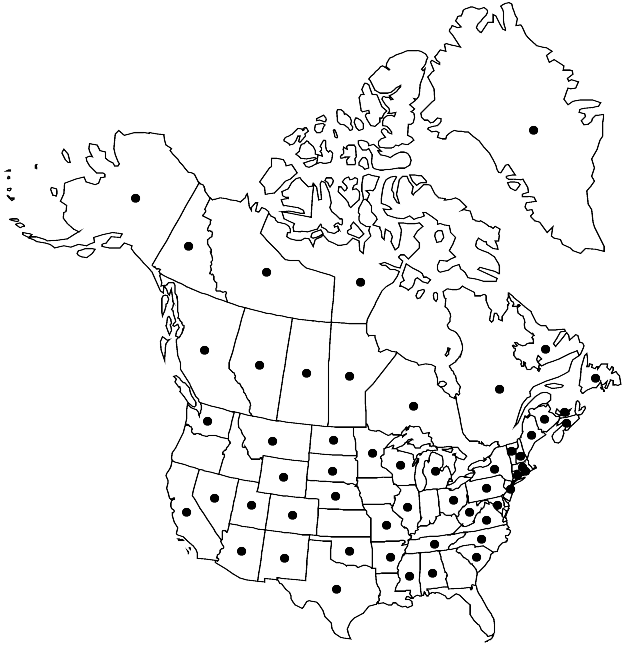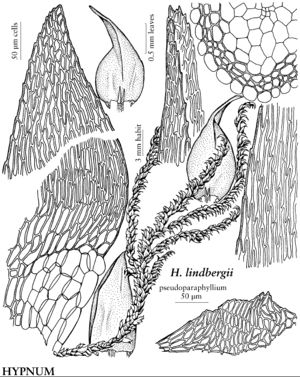Hypnum lindbergii
J. Bot. 2: 123. 1864.
Plants small to large, golden green, yellow-green, or pale green. Stems 1–5 cm, reddish brown to yellowish green, brown with age, suberect to creeping, irregularly to sparsely branched to somewhat pinnate, branches 0.2–2 cm; hyalodermis present, central strand well developed; pseudoparaphyllia foliose. Leaves falcate-secund (sometimes weakly so), oblong-ovate, not or slightly rounded to insertion, tapering gradually to apex, 0.5–2 × 0.5–1 mm; base decurrent; margins plane, entire to bluntly serrate especially in apex; acumen slender or broad; costa double, short; alar cells abruptly enlarged, region well defined, in 2–4 rows along margins, outermost cell walls thinner; basal laminal cells wider, shorter than medial cells, yellowish, walls porose; medial cells 60–100 × 5–6 µm. Sexual condition dioicous; inner perichaetial leaves oblong-lanceolate, margins serrulate at apex, apex attenuate, costa obscure. Seta reddish, 2.5–4 cm. Capsule inclined, pale brown, cylindric, 2–3 mm; annulus 2- or 3-seriate; operculum conic-convex; endostome cilia 2–4.
Phenology: Capsules mature Jun–Aug.
Habitat: Terrestrial, open sites, wet soil, humus, logs, sandy lake and river margins, swamp forests
Elevation: low to high elevations (0-3000 m)
Distribution

Greenland, Alta., B.C., Man., N.B., Nfld. and Labr., N.W.T., N.S., Nunavut, Ont., P.E.I., Que., Sask., Yukon, Ala., Alaska, Ariz., Ark., Calif., Colo., Conn., Ill., Maine, Md., Mass., Mich., Minn., Miss., Mo., Mont., Nebr., Nev., N.H., N.J., N.Mex., N.Y., N.C., N.Dak., Ohio, Okla., Pa., R.I., S.C., S.Dak., Tenn., Tex., Utah, Vt., Va., Wash., W.Va., Wis., Wyo., Europe, Asia.
Discussion
Hypnum lindbergii is a species largely of temperate climates, most frequent in boreal and warm temperate regions, less frequent in the Arctic, occurring from sea level to alpine elevations; sporophytes are infrequently produced in spring and summer. Plants of H. lindbergii have few or no rhizoids; the supra-alar cells are shorter than the alar cells, in 1–3 rows; the capsules are furrowed when dry; and the endostome cilia are as long as the segments. The hyalodermis cortical cells, leaves usually curved to insertion, usually well-defined alar regions of swollen thin-walled cells, and often wide acute apex of many stem leaves usually separate this species from similar taxa. Hypnum pratense resembles H. lindbergii somewhat, but H. pratense tends to be very glossy, with stem leaves often complanate, and thin-walled alar cells absent.
Selected References
None.
